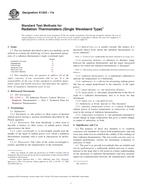Potřebujeme váš souhlas k využití jednotlivých dat, aby se vám mimo jiné mohly ukazovat informace týkající se vašich zájmů. Souhlas udělíte kliknutím na tlačítko „OK“.
ASTM E1256-11a
Standard Test Methods for Radiation Thermometers (Single Waveband Type) (Includes all amendments And changes 7/9/2015).
Automaticky přeložený název:
Standardní zkušební metody pro radiační teploměry (Single Pásmové typ)
NORMA vydána dne 1.5.2011
Informace o normě:
Označení normy: ASTM E1256-11a
Poznámka: NEPLATNÁ
Datum vydání normy: 1.5.2011
Kód zboží: NS-41034
Počet stran: 7
Přibližná hmotnost: 21 g (0.05 liber)
Země: Americká technická norma
Kategorie: Technické normy ASTM
Anotace textu normy ASTM E1256-11a :
Keywords:
blackbody, calibration, field-of-view, long-term stability, radiation thermometer, radiometer, repeatability, response time, temperature, warm-up time, waveband, Blackbody, Calibration--temperature analysis instrumentation, Iris diaphragm diameter, Long-term drift, Radiation thermometers, Radiometers, Response time, Target size, Thermometers, Warm-up time, Waveband, ICS Number Code 17.200.20 (Temperature-measuring instruments)
Doplňující informace
| Significance and Use | ||||
|
The purpose of these test methods is to establish consensus test methods by which both manufacturers and end users may make tests to establish the validity of the readings of their radiation thermometers. The test results can also serve as standard performance criteria for instrument evaluation or selection, or both. The goal is to provide test methods that are reliable and can be performed by a sufficiently skilled end user or manufacturer in the hope that it will result in a better understanding of the operation of radiation thermometers and also promote improved communication between the manufacturers and the end users. A user without sufficient knowledge and experience should seek assistance from the equipment makers or other expert sources, such as those found at the National Institute of Standards and Technology in Gaithersburg, Maryland. Use these test methods with the awareness that there are other parameters, particularly spectral range limits and temperature resolution, which impact the use and characterization of radiation thermometers for which test methods have not yet been developed. Temperature resolution is the minimum simulated or actual change in target temperature that results in a usable change in output or indication, or both. It is usually expressed as a temperature differential or a percent of full-scale value, or both, and usually applies to value measured. The magnitude of the temperature resolution depends upon a combination of four factors: detector noise equivalent temperature difference (NETD), electronic signal processing, signal-to-noise characteristics (including amplification noise), and analog-to-digital conversion “granularity.” Spectral range limits are the upper and lower limits to the wavelength band of radiant energy to which the instrument responds. These limits are generally expressed in micrometers (μm) and include the effects of all elements in the measuring optical path. At the spectral response limits, the transmission of the measuring optics is 5 % of peak transmission (see Fig. 1). |
||||
| 1. Scope | ||||
|
1.1 The test methods described in these test methods can be utilized to evaluate the following six basic operational parameters of a radiation thermometer (single waveband type): |
||||
| 2. Referenced Documents | ||||
|
Odebírejte informace o nově vydaných normách ZDARMA:
Chcete pravidelně odebírat informace o nově vycházejících normách z celého světa a to zcela zdarma?
Přihlašte se k odběru. Vše je velice jednoduché a absolutně ZDARMA.
Na výběr máte vydavatele z celého světa.




 Cookies
Cookies
